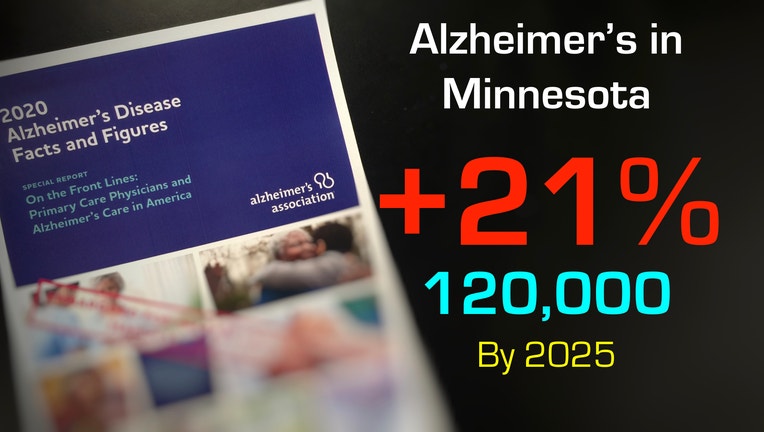'We are not prepared': Experts say Minnesota needs more specialists, caregivers to handle increase in Alzheimer's cases

New data from the Minnesota Alzheimer's Association shows another increase in Alzheimer's cases. Also, more cases are anticipated as the baby boomers reach retirement age.
MINNEAPOLIS (FOX 9) - The number of older Minnesotans developing Alzheimer’s disease is expected to rapidly grow in the next five years according to new estimates from the Alzheimer’s Association of Minnesota.
The Alzheimer’s Association’s new 2020 Facts and Figures Report finds that Alzheimer’s, a deteriorating brain disease, is now the fourth leading cause of death in Minnesota. In 2018, 2,436 people in Minnesota died from Alzheimer’s, but the Alzheimer’s Association says that number does not include the deaths from any type of dementia.

‘We are not prepared’: Experts say Minnesota needs more specialists, caregivers to handle increase in Alzheimer’s cases
The number of older Minnesotans developing Alzheimer’s disease is expected to rapidly grow in the next five years according to new estimates from the Alzheimer’s Association of Minnesota.
In the years to come, Alzheimer’s advocates say the prevalence of the disease is only going to grow. The new report suggests the number of Alzheimer’s patients 65 and older in Minnesota will grow to 120,000 in the next five years. That’s a 21.2% increase. Nearly all of the growth is coming from the last of the baby boom generation heading into retirement age.
“We have a growing and aging population,” said Mollie O’Brien, chief strategy officer for the Alzheimer’s Association of Minnesota and North Dakota.
“Minnesota is a fantastic place to live. Minnesota is a fantastic place to retire. But we are not prepared for this aging population in terms of navigating Alzheimer’s,” said O’Brien.
The Alzheimer’s Association says the expected growth of patients with the disease will greatly test the state’s health care systems. Most medical professionals dealing with Alzheimer’s patients are primary care doctors.
“Fifty percent of primary care physicians are really the front lines of this disease and do not feel that the medical profession is ready to take this on,” said O’Brien.
Advocates say that reality points to the need for more doctors specializing in geriatric medicine. The new Facts and Figures Report finds there are only 93 geriatricians in Minnesota. The Alzheimer’s Association believes the number of geriatric specialists needs to grow by 190% in the next 30 years.
But it’s not just doctors who will feel strained, so will families.
“We also know that there are about three caregivers, three unpaid caregivers for every person living with the disease,” said Beth McMullen, the Alzheimer’s Association’s vice president of government affairs.
“We estimate that there are about 257,000 caregivers,” said McMullen. “Those are unpaid friends and family caring for people living with this disease and that number is only going to increase with the number of people living with the disease increases.”
Advocates says early intervention plays a big role in getting patients into therapies and families plugged into the network of resources they need.
Recognizing the 10 signs is important:
- Memory loss that disrupts daily life
- Challenges in planning or solving problems
- Difficulty completing familiar tasks at home
- Confusion with time or place
- Trouble understanding visual images and special relationships
- New problems with words in speaking or writing
- Misplacing thing s and losing the ability to retrace steps
- Decreased of poor judgement
- Withdrawal from work or social activities
- Changes in mood and personality
“So, in terms of what families should be thinking about, especially those of us with aging parents, is knowing the signs of Alzheimer’s,” said O’Brien. “Knowing where there are resources and support outside and within health care and being able to advocate for our parents within those resources.”
The Alzheimer’s Association has a 24-hour help lines to answer any questions relating to the disease: 800-272-3900.

